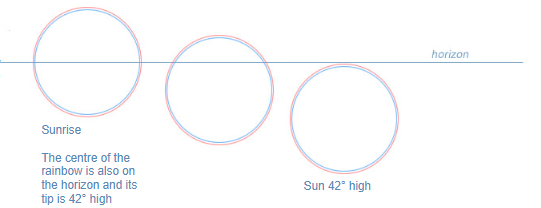Subhorizon Rainbow, Sweden - OPOD
Subhorizon Rainbow, Sweden - OPOD: Exploring the Enigmatic Bow Beneath the Horizon
Rainbows have always fascinated us with their vibrant colors and ethereal beauty. We are familiar with the primary and secondary rainbows, which have their centers directly opposite the sun. However, there are other types of rainbows that exist, including the intriguing subhorizon rainbow. In this article, we will delve into the captivating phenomenon of the subhorizon rainbow, specifically focusing on an awe-inspiring image captured by Magnus Hoog in northern Sweden.
Magnus Hoog's photograph showcases a subhorizon rainbow gracefully nestled in the land below the horizon. Unlike primary and secondary rainbows, which are typically visible in the sky, subhorizon rainbows present themselves in a unique and mesmerizing manner. Let's unravel the secrets of this fascinating atmospheric optics phenomenon.
Unveiling the Subhorizon Rainbow
The subhorizon rainbow derives its name from its position below the horizon. While primary rainbows are visible when the sun is less than 42° high, subhorizon rainbows can be observed when the sun is even lower on the horizon. In fact, the center of the subhorizon rainbow is an astonishing 42° below the horizon, with its tip just grazing the horizon. This positioning creates a breathtaking spectacle that defies our expectations of traditional rainbow formations.
The Optical Mechanism Behind Subhorizon Rainbows
To understand the optical mechanism behind subhorizon rainbows, we must first grasp the fundamentals of how rainbows are formed. Rainbows occur when sunlight interacts with water droplets in the atmosphere, causing the light to refract, reflect, and disperse. The result is a stunning display of colors that we perceive as a rainbow.
In the case of subhorizon rainbows, the sunlight interacts with ice crystals in the atmosphere instead of water droplets. These ice crystals are commonly found in high-altitude cirrus clouds, which often form beautiful and delicate patterns in the sky. The unique shape and orientation of these ice crystals play a crucial role in the formation of subhorizon rainbows.
Ice Crystals and Subhorizon Rainbows
The ice crystals responsible for subhorizon rainbows are typically plate-shaped, resembling tiny hexagonal disks. These crystals tend to orient themselves horizontally as they fall through the atmosphere. As sunlight passes through these horizontally aligned ice crystals, it undergoes a process called refraction, bending the light at specific angles.
The bending of light within the ice crystals is essential for the formation of subhorizon rainbows. As the sunlight enters and exits the ice crystals, it is refracted and dispersed, creating a stunning array of colors. The angle at which the light is bent determines the position and shape of the subhorizon rainbow. Due to the specific alignment of the ice crystals, the subhorizon rainbow forms below the horizon, adding an element of intrigue and wonder to this atmospheric phenomenon.
Capturing the Subhorizon Rainbow in Sweden
Magnus Hoog's remarkable photograph captures the subhorizon rainbow in all its glory from a hillside in northern Sweden. The vivid colors of the rainbow contrast beautifully against the serene landscape, evoking a sense of awe and wonder. This image serves as a testament to the captivating beauty of subhorizon rainbows and their ability to inspire and mesmerize.
The Significance of Subhorizon Rainbows
Subhorizon rainbows hold immense scientific significance as they provide valuable insights into the behavior of light and atmospheric conditions. By studying these enigmatic rainbows, researchers can gain a deeper understanding of the intricate interactions between sunlight, ice crystals, and atmospheric phenomena.
Moreover, subhorizon rainbows serve as a reminder of the boundless wonders that nature has to offer. They remind us to look beyond the familiar and seek out the extraordinary in the world around us. The subhorizon rainbow, with its ethereal presence below the horizon, invites us to marvel at the intricate tapestry of light and color that exists within our atmosphere.
In conclusion, the subhorizon rainbow is a captivating and elusive atmospheric optics phenomenon. Magnus Hoog's photograph from northern Sweden offers a glimpse into the enchanting world of subhorizon rainbows, showcasing their unique beauty and allure. By exploring the optical mechanisms behind their formation and appreciating their significance, we can deepen our appreciation for the wonders of the natural world and find inspiration in its mysterious and breathtaking manifestations.

Low Rainbow ~ Magnus Hoog imaged this bow in northern Sweden from a hillside. The colourful bow nestles in the land below the horizon. Image ©Magnus Hoog.
The familiar primary and secondary rainbows (there are others) have their centres directly opposite the sun. As the sun climbs the rainbow sink. On level ground we can only see a primary rainbow in the sky when the sun is less than 42° high - the radius of the bow.

The centre of the rainbow is also on the horizon and its tip is 42° high
The rainbow's centre is 42° below the horizon and its tip grazes the horizon.
Note: this article has been automatically converted from the old site and may not appear as intended. You can find the original article here.
Reference Atmospheric Optics
If you use any of the definitions, information, or data presented on Atmospheric Optics, please copy the link or reference below to properly credit us as the reference source. Thank you!
-
<a href="https://atoptics.co.uk/blog/subhorizon-rainbow-sweden-opod/">Subhorizon Rainbow, Sweden - OPOD</a>
-
"Subhorizon Rainbow, Sweden - OPOD". Atmospheric Optics. Accessed on November 26, 2024. https://atoptics.co.uk/blog/subhorizon-rainbow-sweden-opod/.
-
"Subhorizon Rainbow, Sweden - OPOD". Atmospheric Optics, https://atoptics.co.uk/blog/subhorizon-rainbow-sweden-opod/. Accessed 26 November, 2024
-
Subhorizon Rainbow, Sweden - OPOD. Atmospheric Optics. Retrieved from https://atoptics.co.uk/blog/subhorizon-rainbow-sweden-opod/.